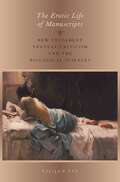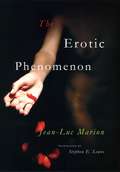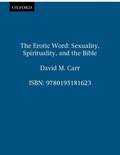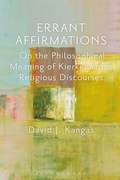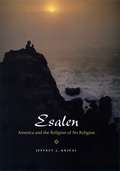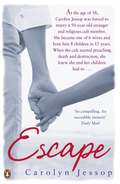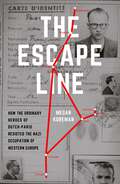- Table View
- List View
The Erotic Life of Manuscripts: New Testament Textual Criticism and the Biological Sciences
by Yii-Jan LinSince the New Testament's inception as written text, its manuscripts have been subject to all the dangers of history: scribal error, emendation, injury, and total destruction. The traditional goal of modern textual criticism has been to reconstruct an "original text" from surviving manuscripts, adjudicating among all the variant texts resulting from the slips, additions, and embellishments of scribal hand-copying. Because of the way manuscripts circulate and give rise to new copies, it can be said that they have an "erotic" life: they mate and breed, bear offspring, and generate families and descendants. New Testament textual critics of the eighteenth century who began to use this language to group texts into families and genealogies were not pioneering new approaches, but rather borrowing the metaphors and methods of natural scientists. Texts began to be classified into "families, tribes, and nations," and later were racialized as "African" or "Asian," with distinguishable "textual physiognomies" and "textual complexions." The Erotic Life of Manuscripts explores this curious relationship between the field of New Testament textual criticism and the biological sciences, beginning with the eighteenth century and extending into the present. While these biological metaphors have been powerful tools for textual critics, they also produce problematic understandings of textual "purity" and agency, with the use of scientific discourse artificially separating the work of textual criticism from literary interpretation. Yii-Jan Lin shows how the use of biological classification, genealogy, evolutionary theory, and phylogenetics has shaped-and limited-the goals of New Testament textual criticism, the greatest of which is the establishment of an authoritative, original text. She concludes by proposing new metaphors for the field.
The Erotic Phenomenon
by Jean-Luc MarionWhile humanists have pondered the subject of love to the point of obsessiveness, philosophers have steadfastly ignored it. One might wonder whether the discipline of philosophy even recognizes love. The word philosophy means “love of wisdom,” but the absence of love from philosophical discourse is curiously glaring. So where did the love go? In The Erotic Phenomenon, Jean-Luc Marion asks this fundamental question of philosophy, while reviving inquiry into the concept of love itself. Marion begins his profound and personal book with a critique of Descartes’ equation of the ego’s ability to doubt with the certainty that one exists—“I think, therefore I am”—arguing that this is worse than vain. We encounter being, he says, when we first experience love: I am loved, therefore I am; and this love is the reason I care whether I exist or not. This philosophical base allows Marion to probe several manifestations of love and its variations, including carnal excitement, self-hate, lying and perversion, fidelity, the generation of children, and the love of God. Throughout, Marion stresses that all erotic phenomena, including sentimentality, pornography, and even boasts about one’s sexual conquests, stem not from the ego as popularly understood but instead from love. A thoroughly enlightening and captivating philosophical investigation of a strangely neglected subject, The Erotic Phenomenon is certain to initiate feverish new dialogue about the philosophical meanings of that most desirable and mysterious of all concepts—love.
The Erotic Phenomenon
by Jean-Luc MarionWhile humanists have pondered the subject of love to the point of obsessiveness, philosophers have steadfastly ignored it. One might wonder whether the discipline of philosophy even recognizes love. The word philosophy means “love of wisdom,” but the absence of love from philosophical discourse is curiously glaring. So where did the love go? In The Erotic Phenomenon, Jean-Luc Marion asks this fundamental question of philosophy, while reviving inquiry into the concept of love itself. Marion begins his profound and personal book with a critique of Descartes’ equation of the ego’s ability to doubt with the certainty that one exists—“I think, therefore I am”—arguing that this is worse than vain. We encounter being, he says, when we first experience love: I am loved, therefore I am; and this love is the reason I care whether I exist or not. This philosophical base allows Marion to probe several manifestations of love and its variations, including carnal excitement, self-hate, lying and perversion, fidelity, the generation of children, and the love of God. Throughout, Marion stresses that all erotic phenomena, including sentimentality, pornography, and even boasts about one’s sexual conquests, stem not from the ego as popularly understood but instead from love. A thoroughly enlightening and captivating philosophical investigation of a strangely neglected subject, The Erotic Phenomenon is certain to initiate feverish new dialogue about the philosophical meanings of that most desirable and mysterious of all concepts—love.
The Erotic Word: Sexuality, Spirituality, And The Bible
by David M. CarrHistorically, the Bible has been used to drive a wedge between the spirit and the body. In this provocative book, David Carr argues that it can--and should--do just the opposite. Sexuality and spirituality, Carr contends, are intricately interwoven: when one is improverished, the other is warped. As a result, the journey toward God and the life-long engagement with our own sexual embodiment are inseparable. Humans, the Bible tells us, both male and female, were created in God's image, and eros--a fundamental longing for connection that finds abstract good in the pleasure we derive from the stimulation of the senses--is a central component of that image. The Bible, particularly the Hebrew Bible, affirms erotic passion, both eros between humans and eros between God and humans. In a sweeping examination of the sexual rules of the Bible, Carr asserts that Biblical "family values" are a far cry from anything promoted as such in contemporary politics. He concludes that passionate love--our preoccupaton therewith and pursuit thereof--is the primary human vocation, that eros is in fact the flavoring of life.
The Erotic Word: Sexuality, Spirituality, and the Bible
by David M. CarrHistorically, the Bible has been used to drive a wedge between the spirit and the body. In this provocative book, David Carr argues that the Bible affirms erotic passion. Sexuality and spirituality, he contends, are intricately interwoven; the journey toward God and the life-long engagement with our own sexual embodiment are inseparable.
Eroticism of More- and Other-than-Human Bodies: A Study of the Anthropology of Things
by Grażyna GajewskaFocusing on non-human actors, Grażyna Gajewska expands the discussion of eroticism in contemporary culture by bringing in material culture, object studies, and “the anthropology of things.” She sets out from the assumption that things (such as, for instance, attire, underwear, shoes, or jewelry) play an important role in arousing erotic imagination—they are genuine participants in the process, not mere signifiers of eroticism. Their use does not denote only undeniable facts of everyday life associated with functionality, the pragmatic or aesthetic aspect, but also contribute to the shaping of human emotions, fantasies and phantasms. In her study, Gajewska brings eroticism in contemporary culture to light through applying gender studies to new contexts—animals, robots, virtual worlds—even as she explores a new methodology, the anthropology of things.
Errand into the Wilderness of Mirrors: Religion and the History of the CIA
by Michael GrazianoMichael Graziano’s intriguing book fuses two landmark titles in American history: Perry Miller’s Errand into the Wilderness (1956), about the religious worldview of the early Massachusetts colonists, and David Martin’s Wilderness of Mirrors (1980), about the dangers and delusions inherent to the Central Intelligence Agency. Fittingly, Errand into the Wilderness of Mirrors investigates the dangers and delusions that ensued from the religious worldview of the early molders of the Central Intelligence Agency. Graziano argues that the religious approach to intelligence by key OSS and CIA figures like “Wild” Bill Donovan and Edward Lansdale was an essential, and overlooked, factor in establishing the agency’s concerns, methods, and understandings of the world. In a practical sense, this was because the Roman Catholic Church already had global networks of people and safe places that American agents could use to their advantage. But more tellingly, Graziano shows, American intelligence officers were overly inclined to view powerful religions and religious figures through the frameworks of Catholicism. As Graziano makes clear, these misconceptions often led to tragedy and disaster on an international scale. By braiding the development of the modern intelligence agency with the story of postwar American religion, Errand into the Wilderness of Mirrors delivers a provocative new look at a secret driver of one of the major engines of American power.
Errand into the Wilderness of Mirrors: Religion and the History of the CIA
by Michael GrazianoMichael Graziano’s intriguing book fuses two landmark titles in American history: Perry Miller’s Errand into the Wilderness (1956), about the religious worldview of the early Massachusetts colonists, and David Martin’s Wilderness of Mirrors (1980), about the dangers and delusions inherent to the Central Intelligence Agency. Fittingly, Errand into the Wilderness of Mirrors investigates the dangers and delusions that ensued from the religious worldview of the early molders of the Central Intelligence Agency. Graziano argues that the religious approach to intelligence by key OSS and CIA figures like “Wild” Bill Donovan and Edward Lansdale was an essential, and overlooked, factor in establishing the agency’s concerns, methods, and understandings of the world. In a practical sense, this was because the Roman Catholic Church already had global networks of people and safe places that American agents could use to their advantage. But more tellingly, Graziano shows, American intelligence officers were overly inclined to view powerful religions and religious figures through the frameworks of Catholicism. As Graziano makes clear, these misconceptions often led to tragedy and disaster on an international scale. By braiding the development of the modern intelligence agency with the story of postwar American religion, Errand into the Wilderness of Mirrors delivers a provocative new look at a secret driver of one of the major engines of American power.
Errand into the Wilderness of Mirrors: Religion and the History of the CIA
by Michael GrazianoReveals the previous underexplored influence of religious thought in building the foundations of the CIA. Michael Graziano’s intriguing book fuses two landmark titles in American history: Perry Miller’s Errand into the Wilderness (1956), about the religious worldview of the early Massachusetts colonists, and David Martin’s Wilderness of Mirrors (1980), about the dangers and delusions inherent to the Central Intelligence Agency. Fittingly, Errand into the Wilderness of Mirrors investigates the dangers and delusions that ensued from the religious worldview of the early molders of the Central Intelligence Agency. Graziano argues that the religious approach to intelligence by key OSS and CIA figures like “Wild” Bill Donovan and Edward Lansdale was an essential, and overlooked, factor in establishing the agency’s concerns, methods, and understandings of the world. In a practical sense, this was because the Roman Catholic Church already had global networks of people and safe places that American agents could use to their advantage. But more tellingly, Graziano shows, American intelligence officers were overly inclined to view powerful religions and religious figures through the frameworks of Catholicism. As Graziano makes clear, these misconceptions often led to tragedy and disaster on an international scale. By braiding the development of the modern intelligence agency with the story of postwar American religion, Errand into the Wilderness of Mirrors delivers a provocative new look at a secret driver of one of the major engines of American power.
Errant Affirmations: On the Philosophical Meaning of Kierkegaard's Religious Discourses
by David J. KangasKierkegaard's religious discourses - his writings which have explicitly dealt with religion - have historically been given scant attention by philosophers. They have generally been considered to be of less philosophical interest than his 'proper' philosophy. Errant Affirmations radically questions this claim and considers Kierkegaard's religious writings as absolutely central to his philosophical vision. Through close and clear readings of Kierkegaard's work, David Kangas argues that contemporary philosophical themes - gift, temporality, language, death, nothingness, economy and selfhood- are not only evident in the 'religious' works but explored with real depth and fascination. Above all, the book argues that Kierkegaard's positive account of the human condition, his “ontology,” fully emerges only in these discourses. It shows how these discourses are organized around an “errant” kind of affirmation-namely, an affirmation of existence that is without conditions. Such affirmation involves the intensification of life around “today” and coincides with a joy that has no particular cause. It is an affirmation capable of affirming life even amidst its finitude and suffering.Errant Affirmations is a fresh interpretation of Kierkegaard's understudied works that not only opens up a new reading of Kierkegaard but elucidates his 'religious' texts and places them organically within his philosophy as a whole.
Errant Affirmations: On the Philosophical Meaning of Kierkegaard's Religious Discourses
by David J. KangasKierkegaard's religious discourses - his writings which have explicitly dealt with religion - have historically been given scant attention by philosophers. They have generally been considered to be of less philosophical interest than his 'proper' philosophy. Errant Affirmations radically questions this claim and considers Kierkegaard's religious writings as absolutely central to his philosophical vision. Through close and clear readings of Kierkegaard's work, David Kangas argues that contemporary philosophical themes - gift, temporality, language, death, nothingness, economy and selfhood- are not only evident in the 'religious' works but explored with real depth and fascination. Above all, the book argues that Kierkegaard's positive account of the human condition, his “ontology,” fully emerges only in these discourses. It shows how these discourses are organized around an “errant” kind of affirmation-namely, an affirmation of existence that is without conditions. Such affirmation involves the intensification of life around “today” and coincides with a joy that has no particular cause. It is an affirmation capable of affirming life even amidst its finitude and suffering.Errant Affirmations is a fresh interpretation of Kierkegaard's understudied works that not only opens up a new reading of Kierkegaard but elucidates his 'religious' texts and places them organically within his philosophy as a whole.
Erring: A Postmodern A/theology
by Mark C. Taylor"Erring is a thoughtful, often brilliant attempt to describe and enact what remains of (and for) theology in the wake of deconstruction. Drawing on Hegel, Nietzsche, Derrida, and others, Mark Taylor extends—and goes well beyond—pioneering efforts. . . . The result is a major book, comprehensive and well-informed."—G. Douglas Atkins, Philosophy and Literature "Many have felt the need for a study which would explicate in coherent and accessible fashion the principal tenets of deconstruction, with particular attention to their theological implications. This need the author has addressed in a most impressive manner. The book's effect upon contemporary discussion is apt to be, and deserves to be, far-reaching."—Walter Lowe, Journal of Religion
Erring: A Postmodern A/theology
by Mark C. Taylor"Erring is a thoughtful, often brilliant attempt to describe and enact what remains of (and for) theology in the wake of deconstruction. Drawing on Hegel, Nietzsche, Derrida, and others, Mark Taylor extends—and goes well beyond—pioneering efforts. . . . The result is a major book, comprehensive and well-informed."—G. Douglas Atkins, Philosophy and Literature "Many have felt the need for a study which would explicate in coherent and accessible fashion the principal tenets of deconstruction, with particular attention to their theological implications. This need the author has addressed in a most impressive manner. The book's effect upon contemporary discussion is apt to be, and deserves to be, far-reaching."—Walter Lowe, Journal of Religion
Erring: A Postmodern A/theology
by Mark C. Taylor"Erring is a thoughtful, often brilliant attempt to describe and enact what remains of (and for) theology in the wake of deconstruction. Drawing on Hegel, Nietzsche, Derrida, and others, Mark Taylor extends—and goes well beyond—pioneering efforts. . . . The result is a major book, comprehensive and well-informed."—G. Douglas Atkins, Philosophy and Literature "Many have felt the need for a study which would explicate in coherent and accessible fashion the principal tenets of deconstruction, with particular attention to their theological implications. This need the author has addressed in a most impressive manner. The book's effect upon contemporary discussion is apt to be, and deserves to be, far-reaching."—Walter Lowe, Journal of Religion
Erring: A Postmodern A/theology
by Mark C. Taylor"Erring is a thoughtful, often brilliant attempt to describe and enact what remains of (and for) theology in the wake of deconstruction. Drawing on Hegel, Nietzsche, Derrida, and others, Mark Taylor extends—and goes well beyond—pioneering efforts. . . . The result is a major book, comprehensive and well-informed."—G. Douglas Atkins, Philosophy and Literature "Many have felt the need for a study which would explicate in coherent and accessible fashion the principal tenets of deconstruction, with particular attention to their theological implications. This need the author has addressed in a most impressive manner. The book's effect upon contemporary discussion is apt to be, and deserves to be, far-reaching."—Walter Lowe, Journal of Religion
Error's Chains: How Forged and Broken, a Complete, Graphic, and Comparative History of the Many Strange Beliefs, Superstitious Practices, Domestic Peculiarities, Sacred Writings, Systems of Philosophy, Legends and Traditions, Customs and Habits of Mankind
by Frank Stockton Dobbins Samuel Wells Williams Isaac Hollister HallEvery nation has its God, or gods, and its corresponding forms of worship. Nothing lies so close to the heart of mankind as its religious faith. Religion in some form is interwoven with the entire fabric of human history. It concerns mans dearest pleasures, his fondest hopes, and his highest aspirations. Man must worship. It is part of his nature to worship. Hence, from the most civilized European to the half-civilized Chinaman, and even down to the degraded Hottentot; in all stages of mans existence, among all races and classes, some form of worship is found. Nothing surely can interest us more than the story of that faith in which our fellow-creatures have lived and died.
The Errors of Atheism
by J. Angelo CorlettThe Errors of Atheism is a response to the glaring gap that exists in analytical philosophy on the concept of God. While there is the large body of work that either defends or challenges orthodox Christian theistic arguments, there is a lack of analytical philosophical work articulating agnosticism as a critique of both theism and atheism. J. Angelo Corlett shows that the conceptual depths of theism must be explored beyond orthodoxy in order to re-open the debate on the problem of God. His book is an agnostic's statement on thecurrent state of the debate about God's existence and where the discussion must go to make genuine philosophical progress instead of remaining in a dialectical stalemate.
Esalen: America and the Religion of No Religion
by Jeffrey J. KripalJeffrey Kripal here recounts the spectacular history of Esalen, the institute that has long been a world leader in alternative and experiential education and stands today at the center of the human potential movement. Forged in the literary and mythical leanings of the Beat Generation, inspired in the lecture halls of Stanford by radical scholars of comparative religion, the institute was the remarkable brainchild of Michael Murphy and Richard Price. Set against the heady backdrop of California during the revolutionary 1960s, Esalen recounts in fascinating detail how these two maverick thinkers sought to fuse the spiritual revelations of the East with the scientific revolutions of the West, or to combine the very best elements of Zen Buddhism, Western psychology, and Indian yoga into a decidedly utopian vision that rejected the dogmas of conventional religion. In their religion of no religion, the natural world was just as crucial as the spiritual one, science and faith not only commingled but became staunch allies, and the enlightenment of the body could lead to the full realization of our development as human beings. “An impressive new book. . . . [Kripal] has written the definitive intellectual history of the ideas behind the institute.”—San Francisco Chronicle “Kripal examines Esalen’s extraordinary history and evocatively describes the breech birth of Murphy and Price’s brainchild. His real achievement, though, is effortlessly synthesizing a dizzying array of dissonant phenomena (Cold War espionage, ecstatic religiosity), incongruous pairings (Darwinism, Tantric sex), and otherwise schizy ephemera (psychedelic drugs, spaceflight) into a cogent, satisfyingly complete narrative.”—Atlantic Monthly “Kripal has produced the first all-encompassing history of Esalen: its intellectual, social, personal, literary and spiritual passages. Kripal brings us up-to-date and takes us deep beneath historical surfaces in this definitive, elegantly written book.”—Playboy
Escape
by Carolyn JessopIn the closed world of the Fundamentalist Church of Latter Day Saints, Carolyn Jessop was forced to obey her controlling husband's every demand. She had no money, no power and existed as one of six wives battling for her husband's attention. For seventeen years Carolyn suffered for the sake of her children. She tried to protect them as the cult's new leader, Warren Jeffs, started marrying girls off younger and younger. But when Carolyn discovered that her twelve-year-old daughter had spent three days at Jeffs' home, she knew she had to do everything in her power to take her children and flee.At 35 Carolyn escaped. This is her harrowing - and ultimately triumphant - story
Escape from the Badlands (Mills And Boon Love Inspired Suspense Ser.)
by Dana MentinkA BROTHER’S PROMISE
The Escape Line: How the Ordinary Heroes of Dutch-Paris Resisted the Nazi Occupation of Western Europe
by Megan KoremanOf all the resistance organizations that operated during the war, about which much has been written, one stands out for its transnational character, the diversity of the tasks its members took on, and the fact that, unlike many of the known evasion lines, it was not directed by Allied officers, but rather by group of ordinary citizens. Between 1942 and 1945, they formed a network to smuggle Dutch Jews and others targeted by the Nazis south into France, via Paris, and then to Switzerland. This network became known as the Dutch-Paris Escape Line, eventually growing to include 300 people and expanding its reach into Spain. Led by Jean Weidner, a Dutchman living in France, many lacked any experience in clandestine operations or military tactics, and yet they became one of the most effective resistance groups of the Second World War. Dutch-Paris largely improvised its operations-scrounging for food on the black market, forging documents, and raising cash. Hunted relentlessly by the Nazis, some were even captured and tortured. In addition to Jews, those it helped escape the clutches of the Nazis included resistance fighters, political foes, Allied airmen, and young men looking to get to London to enlist. As the need grew more desperate, so did the bravery of those who rose to meet it. Using recently declassified archives, The Escape Line tells the story of the Dutch-Paris and the thousands of people it saved during World War II. Author Megan Koreman, who was given exclusive access to many of the archives, is herself the daughter of Dutch parents who were part of the resistance.
ESCAPE LINE C: How the Ordinary Heroes of Dutch-Paris Resisted the Nazi Occupation of Western Europe
by Megan KoremanOf all the resistance organizations that operated during the war, about which much has been written, one stands out for its transnational character, the diversity of the tasks its members took on, and the fact that, unlike many of the known evasion lines, it was not directed by Allied officers, but rather by group of ordinary citizens. Between 1942 and 1945, they formed a network to smuggle Dutch Jews and others targeted by the Nazis south into France, via Paris, and then to Switzerland. This network became known as the Dutch-Paris Escape Line, eventually growing to include 300 people and expanding its reach into Spain. Led by Jean Weidner, a Dutchman living in France, many lacked any experience in clandestine operations or military tactics, and yet they became one of the most effective resistance groups of the Second World War. Dutch-Paris largely improvised its operations-scrounging for food on the black market, forging documents, and raising cash. Hunted relentlessly by the Nazis, some were even captured and tortured. In addition to Jews, those it helped escape the clutches of the Nazis included resistance fighters, political foes, Allied airmen, and young men looking to get to London to enlist. As the need grew more desperate, so did the bravery of those who rose to meet it. Using recently declassified archives, The Escape Line tells the story of the Dutch-Paris and the thousands of people it saved during World War II. Author Megan Koreman, who was given exclusive access to many of the archives, is herself the daughter of Dutch parents who were part of the resistance.
Escaped Nuns: True Womanhood and the Campaign Against Convents in Antebellum America
by Cassandra L. YacovazziJust five weeks after its publication in January 1836, Awful Disclosures of the Hotel Dieu Nunnery, billed as an escaped nun's shocking exposé of convent life, had already sold more than 20,000 copies. The book detailed gothic-style horror stories of licentious priests and abusive mothers superior, tortured nuns and novices, and infanticide. By the time the book was revealed to be a fiction and the author, Maria Monk, an imposter, it had already become one of the nineteenth century's best-selling books. In antebellum America only one book, Uncle Tom's Cabin, outsold it. The success of Monk's book was no fluke, but rather a part of a larger phenomenon of anti-Catholic propaganda, riots, and nativist politics. The secrecy of convents stood as an oblique justification for suspicion of Catholics and the campaigns against them, which were intimately connected with cultural concerns regarding reform, religion, immigration, and, in particular, the role of women in the Republic. At a time when the term "female virtue" pervaded popular rhetoric, the image of the veiled nun represented a threat to the established American ideal of womanhood. Unable to marry, she was instead a captive of a foreign foe, a fallen woman, a white slave, and a foolish virgin. In the first half of the nineteenth century, ministers, vigilantes, politicians, and writers--male and female--forged this image of the nun, locking arms against convents. The result was a far-reaching antebellum movement that would shape perceptions of nuns, and women more broadly, in America.
Escaped Nuns: True Womanhood and the Campaign Against Convents in Antebellum America
by Cassandra L. YacovazziJust five weeks after its publication in January 1836, Awful Disclosures of the Hotel Dieu Nunnery, billed as an escaped nun's shocking exposé of convent life, had already sold more than 20,000 copies. The book detailed gothic-style horror stories of licentious priests and abusive mothers superior, tortured nuns and novices, and infanticide. By the time the book was revealed to be a fiction and the author, Maria Monk, an imposter, it had already become one of the nineteenth century's best-selling books. In antebellum America only one book, Uncle Tom's Cabin, outsold it. The success of Monk's book was no fluke, but rather a part of a larger phenomenon of anti-Catholic propaganda, riots, and nativist politics. The secrecy of convents stood as an oblique justification for suspicion of Catholics and the campaigns against them, which were intimately connected with cultural concerns regarding reform, religion, immigration, and, in particular, the role of women in the Republic. At a time when the term "female virtue" pervaded popular rhetoric, the image of the veiled nun represented a threat to the established American ideal of womanhood. Unable to marry, she was instead a captive of a foreign foe, a fallen woman, a white slave, and a foolish virgin. In the first half of the nineteenth century, ministers, vigilantes, politicians, and writers--male and female--forged this image of the nun, locking arms against convents. The result was a far-reaching antebellum movement that would shape perceptions of nuns, and women more broadly, in America.
Escaping the World: Women Renouncers among Jains (South Asian History and Culture)
by Manisha SethiThe book attends to a historical question — how to account for the high numbers of renouncers (sadhvis) mentioned in medieval and ancient texts — which has been acknowledged and raised, but left unaddressed within Jain studies. It does so through ethnographic data gathered through extensive fieldwork among the sadhvis in Delhi and Jaipur. The volume foregrounds the primacy of ‘choice’ and ‘agency’— upheld by the nuns themselves, who associate asceticism with autonomy, freedom, joy, spiritual well-being, self-worth and peace, and grihastha (household) with loss of independence, fettered existence, degradation, burdensome familial obligations and social responsibilities. It also examines whether it may be apt to term Jain nuns as practitioners of an ‘indigenous mode of feminism’. The book challenges the existing sociological theories of renunciation and tests the feminist concepts of agency and autonomy by investigating the culturally coded roles ascribed to women in Jainism, which are variegated, and examines how a fractured discourse and reality is resolved in the subjectivities and identities of female ascetics. The very legitimacy of the institution of female asceticism, and the way in which the society (samaj) upholds and sustains it, renders female asceticism into a socially approved alternative institution — albeit one that allows Jain nuns to create spaces of relative and autonomy and even prestige for themselves.
